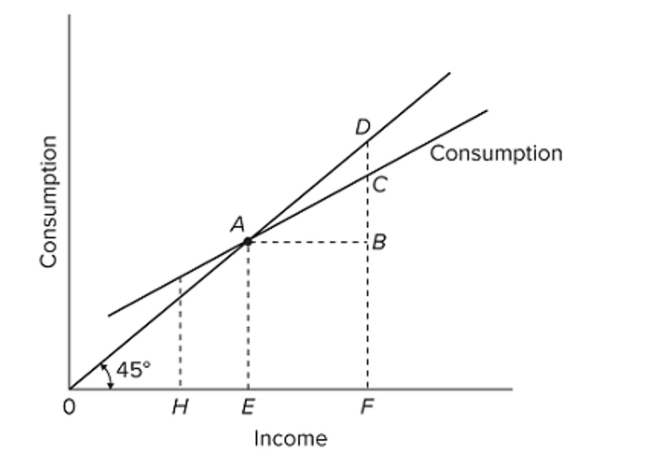A) $3 billion.
B) $2/3 billion.
C) $6 billion.
D) $2 billion.
Correct Answer

verified
Correct Answer
verified
Multiple Choice
Which one of the following will cause a movement up along an economy's saving schedule?
A) an increase in household borrowing
B) an increase in disposable income
C) an increase in stock prices
D) an increase in interest rates
Correct Answer

verified
Correct Answer
verified
True/False
If the MPC is constant at various levels of income, then the APC must also be constant at all of those income levels.
Correct Answer

verified
Correct Answer
verified
Multiple Choice
The 45-degree line on a graph relating consumption and income shows
A) all the points where the MPC is constant.
B) all the points at which saving and income are equal.
C) all the points at which consumption and income are equal.
D) the amounts households will plan to save at each possible level of income.
Correct Answer

verified
Correct Answer
verified
Multiple Choice
The fraction, or percentage, of total income that is saved is called the
A) average propensity to save.
B) marginal propensity to save.
C) disposable income schedule.
D) saving schedule.
Correct Answer

verified
Correct Answer
verified
True/False
The average propensity to consume is defined as income divided by consumption.
Correct Answer

verified
Correct Answer
verified
Multiple Choice
The immediate determinants of investment spending are the
A) expected rate of return on capital goods and the real interest rate.
B) level of saving and the real interest rate.
C) marginal propensity to consume and the real interest rate.
D) interest rate and the expected price level.
Correct Answer

verified
Correct Answer
verified
Multiple Choice
In an economy, for every $1,600 decrease in income, spending falls by $1,200. It can be concluded that the
A) slope of the saving schedule is 1.33.
B) slope of the saving schedule is 0.75.
C) marginal propensity to consume is 1.33.
D) marginal propensity to save is 0.25.
Correct Answer

verified
Correct Answer
verified
Multiple Choice
Assume that an increase in a household's disposable income from $40,000 to $48,000 leads to an increase in consumption from $35,000 to $41,000, then the
A) slope of the consumption schedule is 0.75.
B) average propensity to consume is 0.75.
C) marginal propensity to save is 0.20.
D) marginal propensity to consume is 0.6.
Correct Answer

verified
Correct Answer
verified
Multiple Choice
 Refer to the given consumption schedules. DI signifies disposable income and C represents consumption expenditures. All figures are in billions of dollars. A $2 billion increase in consumption at
Each level of DI could be caused by
Refer to the given consumption schedules. DI signifies disposable income and C represents consumption expenditures. All figures are in billions of dollars. A $2 billion increase in consumption at
Each level of DI could be caused by
A) a decrease in consumer wealth.
B) new expectations of higher future income.
C) an increase in taxation.
D) an increase in saving.
Correct Answer

verified
Correct Answer
verified
Multiple Choice
In a private closed economy, national income is $4.5 trillion and saving equals $6.4 billion. Based on these data, the marginal propensity to consume
A) decreases as income increases.
B) is greater than the marginal propensity to save.
C) is less than the average propensity to consume.
D) cannot be calculated from the data given.
Correct Answer

verified
Correct Answer
verified
Multiple Choice
The multiplier applies to
A) investment but not to net exports or government spending.
B) investment, net exports, and government spending.
C) increases in spending but not to decreases in spending.
D) spending by the private sector but not by the public sector.
Correct Answer

verified
Correct Answer
verified
Multiple Choice
The consumption schedule directly relates
A) consumption to the level of disposable income.
B) saving to the level of disposable income.
C) disposable income to domestic income.
D) consumption to saving.
Correct Answer

verified
Correct Answer
verified
Multiple Choice
Refer to the given table, which illustrates the multiplier process. The total change in income resulting from the initial change in investment will be
A) $100.
B) $20.
C) $80.
D) $200.
Correct Answer

verified
Correct Answer
verified
Multiple Choice
The saving schedule shows the relationship of saving of households to the level of
A) consumption.
B) investment.
C) disposable income.
D) the average propensity to save.
Correct Answer

verified
Correct Answer
verified
True/False
Investment is highly stable; it increases over time at a very steady rate.
Correct Answer

verified
Correct Answer
verified
Multiple Choice
The amount of consumption in an economy correlates
A) inversely with the level of disposable income.
B) directly with the level of disposable income.
C) directly with the level of saving.
D) directly with the rate of interest.
Correct Answer

verified
Correct Answer
verified
Multiple Choice
A rightward shift of the investment demand curve might be caused by
A) an increase in the price level.
B) a decline in the real interest rate.
C) businesses planning to increase their stock of inventories.
D) an increase in business taxes.
Correct Answer

verified
Correct Answer
verified
Multiple Choice
 Refer to the given diagram. The marginal propensity to save is
Refer to the given diagram. The marginal propensity to save is
A) CD/EF.
B) CB/CF.
C) CB/AF.
D) EF/CB.
Correct Answer

verified
Correct Answer
verified
Multiple Choice
Investment spending in the United States tends to be unstable because
A) profits are highly variable.
B) the price level fluctuates rapidly.
C) investment spending is affected by interest rates.
D) capital wears out quickly and must be replaced often.
Correct Answer

verified
Correct Answer
verified
Showing 161 - 180 of 233
Related Exams